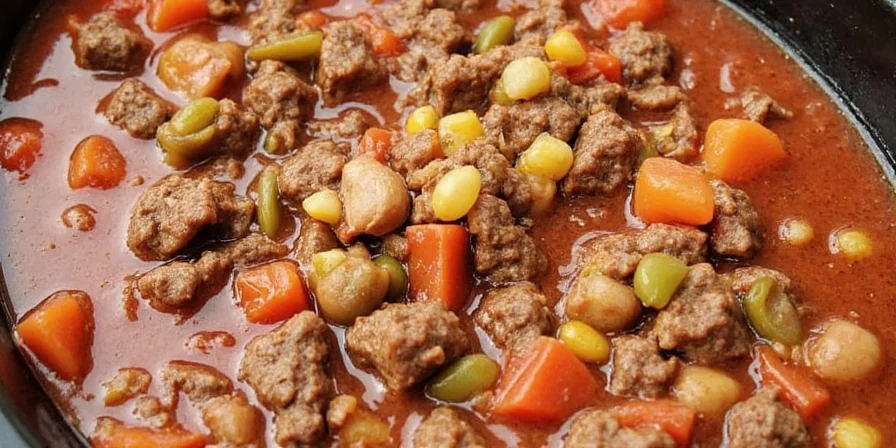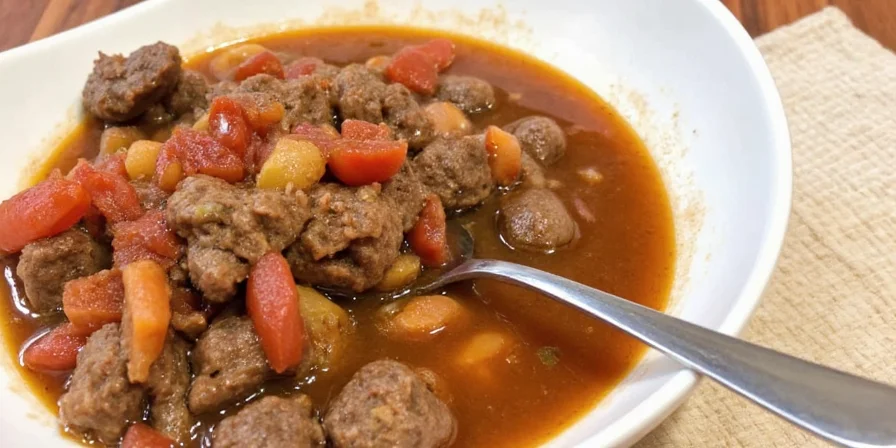
The best beef stew seasoning blend combines 1.5 tbsp salt, 1 tbsp black pepper, 1 tbsp garlic powder, 1 tbsp onion powder, 1 tbsp paprika, 1 tsp dried thyme, ½ tsp marjoram, and ¼ tsp allspice for 3-4 lbs of beef. This simple mix creates deep, complex flavors without overwhelming the natural taste of the meat. Here's exactly how to use these seasonings for tender, flavorful stew every time.
Table of Contents
- The Essential Beef Stew Seasoning Blend (Quick Reference)
- What You Really Need to Season Beef Stew
- Simple Homemade Seasoning Recipe (5 Minutes)
- When to Add Each Spice for Best Results
- Common Mistakes That Ruin Beef Stew Flavor
- Flavor Variations for Different Tastes
- FAQ: Quick Answers to Seasoning Questions
The Essential Beef Stew Seasoning Blend (Quick Reference)

Forget complicated recipes. For truly flavorful beef stew, you only need these 7 pantry staples in the right proportions:
- Salt - enhances natural meat flavors
- Black pepper - adds warmth without heat
- Garlic powder - creates savory depth
- Onion powder - provides subtle sweetness
- Paprika - gives rich color and mild sweetness
- Thyme - classic herb that complements beef
- Bay leaf - adds complexity during cooking
| Spice | For 3-4 lbs Beef | What It Does |
|---|---|---|
| Salt | 1.5 tbsp | Brings out meat's natural flavor |
| Black Pepper | 1 tbsp | Adds warmth without spiciness |
| Garlic Powder | 1 tbsp | Creates rich savory notes |
| Onion Powder | 1 tbsp | Provides background sweetness |
| Paprika | 1 tbsp | Deepens color and flavor |
| Thyme | 1 tsp dried or 1 sprig fresh | Classic beef complement |
| Bay Leaf | 1-2 leaves | Adds subtle complexity |
What You Really Need to Season Beef Stew
Many home cooks make beef stew that tastes flat because they use the wrong spices or add them at the wrong time. The secret isn't complicated ingredients—it's using basic spices correctly.
Professional chefs know that proper seasoning happens in stages:
- Before cooking: Salt the meat to enhance texture
- During searing: Add hardy spices that can withstand high heat
- During simmering: Add mid-level spices that need time to develop
- Before serving: Adjust with finishing touches
Most mistakes happen because people add all spices at the beginning or use pre-made mixes that don't account for how flavors develop during cooking.
Simple Homemade Seasoning Recipe (5 Minutes)

Basic Beef Stew Seasoning Mix
This is all you need for 3-4 servings of rich, flavorful stew:
- 1.5 tbsp kosher salt (or 1 tbsp table salt)
- 1 tbsp freshly ground black pepper
- 1 tbsp garlic powder
- 1 tbsp onion powder
- 1 tbsp paprika (regular or smoked)
- 1 tsp dried thyme (or 1 sprig fresh)
- 1-2 bay leaves
Mix these together in a small bowl. Use immediately or store in an airtight container for up to 6 months.
When to Add Each Spice for Best Results

Timing matters more than most recipes tell you. Here's the chef-recommended sequence:
- Before cooking: Sprinkle ½ tbsp salt on cubed beef and let sit 20 minutes
- During searing: Add 1 tbsp salt, all pepper, garlic powder, onion powder, and paprika to the pot
- After adding liquid: Stir in thyme and bay leaves
- Last 30 minutes: Remove bay leaves and adjust salt to taste
- Before serving: Add a splash of vinegar or lemon juice to brighten flavors
| Cooking Stage | Spices to Add | Why This Timing Works |
|---|---|---|
| Prep (20 min before) | Salt on meat | Draws out moisture for better sear |
| Searing | Salt, pepper, garlic, onion, paprika | Creates flavorful fond in the pot |
| Simmering start | Thyme, bay leaves | Needs time to release flavor gradually |
| Last 30 minutes | Remove bay leaves | Prevents bitter flavor from overcooking |
| Just before serving | Vinegar or lemon juice | Brightens flavors that mellow during cooking |
Common Mistakes That Ruin Beef Stew Flavor

Avoid these 5 errors that make beef stew taste bland or off:
- Mistake #1: Adding all spices at the beginning (delicate flavors burn off)
- Mistake #2: Using old spices (most lose potency after 6 months)
- Mistake #3: Not salting meat ahead (results in less flavorful meat)
- Mistake #4: Forgetting acid at the end (stew tastes flat without brightness)
- Mistake #5: Overcomplicating with too many spices (distracts from beef flavor)
Flavor Variations for Different Tastes
Once you master the basic blend, try these simple adjustments:
- For richer flavor: Add 1 tsp tomato paste when searing
- For smoky depth: Use smoked paprika instead of regular
- For brightness: Add 2 tbsp red wine vinegar at the end
- For earthy notes: Include ½ tsp dried rosemary with thyme
- For subtle warmth: Add ¼ tsp cayenne with other spices
| Flavor Profile | Simple Adjustments | Best Paired With |
|---|---|---|
| Classic Comfort | Basic blend + extra thyme | Carrots, potatoes, peas |
| Smoky Depth | Smoked paprika + dash liquid smoke | Beef short ribs, mushrooms |
| Bright & Fresh | Extra bay leaf + finishing vinegar | Turnips, parsnips, green beans |
| Hearty Winter | Extra garlic + pinch nutmeg | Butternut squash, celery root |
FAQ: Quick Answers to Seasoning Questions
How much seasoning should I use for beef stew?
For 3-4 pounds of beef, use 1.5 tbsp salt, 1 tbsp black pepper, 1 tbsp garlic powder, 1 tbsp onion powder, 1 tbsp paprika, 1 tsp thyme, and 1-2 bay leaves. This creates balanced flavor without overwhelming the meat.
When should I add spices to beef stew?
Add salt to meat 20 minutes before cooking. During searing, add salt, pepper, garlic, onion, and paprika. Add thyme and bay leaves when you add liquid. Remove bay leaves in the last 30 minutes. Finish with a splash of vinegar or lemon juice just before serving.
Can I use fresh herbs instead of dried?
Yes, but use three times the amount of fresh herbs. Add fresh thyme at the beginning with dried herbs, but add delicate fresh herbs like parsley in the last 10 minutes. Bay leaves should always be used dried.
Why does my beef stew taste bland?
Bland stew usually needs more salt or acid. Many recipes don't account for how flavors mellow during long cooking. Always adjust salt at the end, and add 1-2 tsp vinegar or lemon juice just before serving to brighten flavors.
Do I really need bay leaves?
Yes, bay leaves add subtle complexity that's hard to replicate. Use 1-2 leaves per pot and remove them before serving (they don't soften during cooking). If you don't have bay leaves, substitute with a pinch of oregano, but the flavor won't be quite the same.












 浙公网安备
33010002000092号
浙公网安备
33010002000092号 浙B2-20120091-4
浙B2-20120091-4